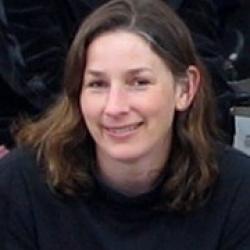
 As a researcher, Lisa Snyder spends a great deal of time immersed in the past, creating real-time, three-dimensional digital models of historic environments. But in her role at the Institute for Digital Research and Education, Snyder, the technologist, is decidedly forward-looking, focusing on cutting-edge technology as she lends her expertise to other researchers.
As a researcher, Lisa Snyder spends a great deal of time immersed in the past, creating real-time, three-dimensional digital models of historic environments. But in her role at the Institute for Digital Research and Education, Snyder, the technologist, is decidedly forward-looking, focusing on cutting-edge technology as she lends her expertise to other researchers.
Snyder’s primary areas of specialty at IDRE are modeling, visualization and Geographic Information Systems (GIS).
The applications for GIS, a system that analyzes and presents geographical data in a visual form, are broad and varied. From mapping modern cities to mapping ancient civilizations, it has become a valuable visualization tool for researchers. Snyder works with campus GIS coordinator Yoh Kawano, an IDRE technologist, in this area.
“GIS is becoming standard at research institutions because it’s a very current way to process and look at data with some immediate visual results that bring clarity to large data sets and illustrate associations of disparate data sets and how they interact,” Snyder said. “It’s a hot area of study, and there’s value in having faculty with that expertise. We can suggest technology, or work done in that area that we can point to for inspiration. Essentially we consult with our researchers.”
Snyder’s personal research specialty involves creating highly detailed computer reconstructions of architecturally and historically important sites. Recreations of Jerusalem’s Temple Mount and the world’s Columbian Exposition of 1893 are two of her renowned works. An architectural historian with a Ph.D. from UCLA, she brings a wealth of knowledge to her role as IDRE’s primary modeling specialist.
“We work with students and project teams as they come through,” Snyder said. “Individual researchers have very individual research questions and individual methods or resolving them.”
One of IDRE’s major goals is to encourage collaboration between faculty from different departments and disciplines. Snyder is a member of IDRE’s Humanities, Arts and Architecture, Social Sciences, and Information Studies, or HASIS, group, which serves to align the computational research interests of south campus with the social research interests of north campus.
Research involving the so-called soft sciences typically doesn’t require the computing power of a cluster, but is geared more toward digitally enabled projects.
“There is no one technology magic bullet,” Snyder said. “But there is a broad range of software tools for visualization that have application for north campus. HASIS hopes to create a virtual community of experts for social research.”
Snyder, who recently teamed with IDRE colleague Scott Friedman to develop a new software interface, VSim, that will provide users with the ability to annotate and construct narratives within 3D computer models, finds herself continually looking forward. What’s next for UCLA researchers?
“We’re planning a November summit of the north campus folks to talk about our resource infrastructure, and the resources we need to support digital research,” she said. “We want to determine our needs and position ourselves five and 10 years out.”